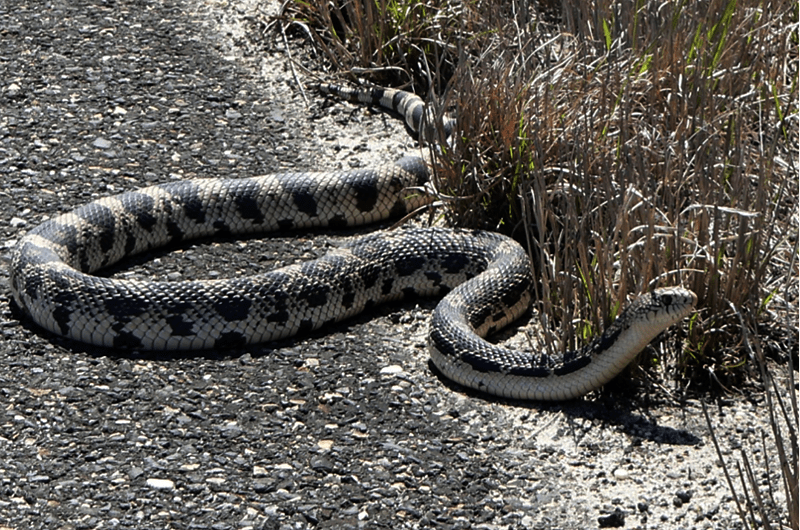Roadside Research from the New Jersey Pinelands and Coast to Coast
 By Rachel Ewing
By Rachel Ewing

- New Data Finds Health Care Organizations May Not Be Doing Enough to Connect Patients with Housing Services When They’re Needed Most.
- New Research Finds Fluorescence in Feathers of Long-eared Owls
- Drexel Researchers Develop New DNA Test For BV
- Dragons on Fire: Kudos for Student Achievement: Winter 2025

“Roads are essentially the primary feature of human civilization at this point,” according to Dane Ward, a doctoral student in environmental science at Drexel University who is presenting research at the Ecological Society of America (ESA) meeting.
Perhaps not surprisingly, Ward, along with fellow doctoral students Ryan Rebozo and Kevin P.W. Smith from the Laboratory of Pinelands Research led by Walter Bien, PhD in Drexel’s College of Arts and Sciences, took advantage of a cross-country roadtrip from Philadelphia to the meeting in Sacramento this week for some extra ecological data collection.
“While traveling across the country and passing through different types of environments, we stopped every few hundred miles to evaluate the immediate roadside vegetation and comparing that to the plants in the natural environments 20 meters away from the road.”
Their cross-country look at roadside ecology is a new venture, but their scientific work closer to home in the New Jersey Pinelands also has a relationship to the road.
What Flower Prefers to Grow After You Mow?
What Flower Prefers to Grow After You Mow?
But the gentian and other early successional species in the Pine Barrens are growing rare because of human intervention: suppressing wildfires, which are the most common natural disturbance in the area. The Pine Barrens of New Jersey are second only to California in the frequency of wildfires. Suppressing them protects human lives nearby, but means there are far fewer disturbed places where gentians prefer to grow.
Is mowing – including roadside mowing – an effective replacement for wildfires to help sustain the Pine Barrens gentian population? That is one of the questions Rebozo is addressing in research he will present at the Ecological Society of America meeting on Aug. 13.
Rebozo said that currently both mowing and prescribed burns are rarely used as management practices for successional species in the Pine Barrens. For his research, he worked with the New Jersey Air National Guard to implement prescribed burns for experimental purposes at the Warren Grove Range, where Drexel’s Laboratory of Pinelands Research conducts environmental research. Rebozo also identified sites where gentians grow unmanaged or mowed, including one mowed roadside site where gentians happened to grow.
Rebozo found that where mowing and burning disturbances were introduced, the gentians responded with increased plant density (more than doubled at some sites), flowering percentage and patch size – often within one year of the disturbance.
Prescribed burns had an even stronger positive impact on gentian growth and reproduction than mowing did.
“With a burn comes not only clearing of vegetation, but also an influx of nutrients,” Rebozo said. “The plants respond well to that in terms of flowering and the number of seeds they set the next year.”
When Snakes Meet the New Jersey Highway
Roads are a challenge for northern pine snakes (Pituophis melanoleucus) in the New Jersey Pine Barrens, based on the findings that Ward will present at the ESA meeting on Aug. 15. At this meeting, Ward will also become chair of the student section of ESA, after serving as vice chair for the past year.
[iframe width="600" height="338" src="//www.youtube.com/embed/XCKz1VQ26gQ?rel=0" frameborder="0" allowfullscreen]
[iframe width="600" height="338" src="//www.youtube.com/embed/XCKz1VQ26gQ?rel=0" frameborder="0" allowfullscreen]
“Then we used that knowledge and looked at the landscape,” Ward said.
In New Jersey, the most densely populated state in the country, the network of roads can dramatically shape the area of land that snake populations can occupy without facing significant risk of population loss during road crossings.
“Roads reduce the number of snakes we can have by creating more small patches of usable habitat, in many cases too small to support even a single pine snake,” Ward said.
Ward analyzed the road layout and habitat types in the pine snake’s historic range in New Jersey and identified a total of 3,872 habitat patches divided by roads and natural barriers. Of those, only 156 patches were of a large enough size to support a small population of 3-5 adult snakes.
Ward said this work has helped inform ongoing efforts in the state to mitigate the impact of roads and provide connectivity for snakes and other wildlife to cross them safely. Two years ago, the New Jersey Air National Guard agreed to participate in a pilot study to test the feasibility of using culverts to guide snakes under roads as part of a larger study of northern pine snakes at Warren Grove Gunnery Range. The New Jersey State Department of Transportation installed culverts under portions of the Atlantic City Expressway last year.
Newborn Snakes Finding Their Path Through Life
“Most reptiles are great mapmakers,” said Smith, a doctoral student in Drexel’s Laboratory of Pinelands Research who will present research on northern pine snakes at the ESA meeting on Aug. 14. At the meeting, Smith is also serving as the student liaison to the education diversity council.
Adult snakes tend to have a good idea of where they are and what is around them, but neonates, or newborn snakes, don’t have those mental maps established when they first emerge from the nest. Smith is tracking neonate pine snakes to find out where they go and where they stay to get a deeper picture of the species’ habitat needs. He is supplementing that tracking with simple experiments to find out why snakes might go one way or another.
[iframe width="600" height="450" src="//www.youtube.com/embed/0aycaVXP2_M?rel=0" frameborder="0" allowfullscreen]
Smith’s tracking of neonate pine snakes over two years has shown that the young snakes stay fairly close to the nest in their first year – ranging from 30 to about 250 meters away – but use a wide range of habitat types. Smith’s study site offers a range of uplands, lowlands, transitional zones, swamps and cranberry bogs. Although pine snakes are considered an upland species, the neonates moved readily through lowlands and wetlands, as well as grassy areas.
Smith has also performed behavioral experiments with neonate snakes to test the hypothesis that their movements could be influenced by social factors.
“Sometimes more than one female pine snake will nest in a single burrow,” Smith said. “The neonates may then come out with some siblings and some non-siblings. Do they have preferences in whose scent trail they follow?”
Using a simple Y-shaped maze test, he is trying to find out if neonate snakes prefer to follow their siblings or unrelated neonates.
[iframe width="600" height="450" src="//www.youtube.com/embed/3NaQU70ILyM?rel=0" frameborder="0" allowfullscreen]
For information about earlier phases of the pine snake research that Smith, Ward and other members of the Bien lab at Drexel presented at ESA last year, see the Drexel News Blog post here.
In This Article
Contact
Drexel News is produced by
University Marketing and Communications.